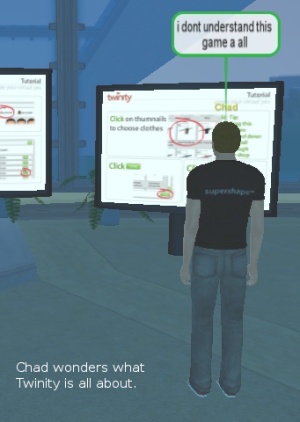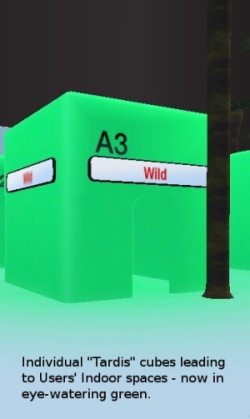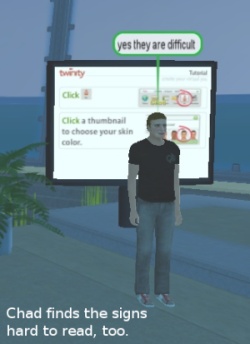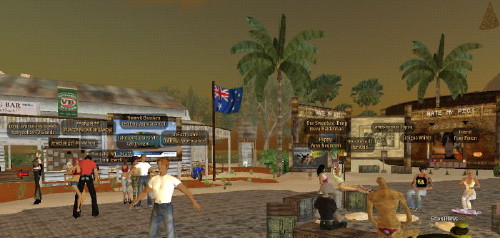“Twinity – the virtual world that mashes up the real with the virtual world”, proclaims their website. However, Twinity is no more of a mashup of the real and virtual worlds than any other virtual world. It’s a world of real people meeting other real people, filled with real digital content, all set against a backdrop of digital representations of real places and places that could exist in real life. What’s new here, if anything, and where might Twinity fit in the greater scheme of things?

Like many mashups, the main justification for their existence is convenience: bringing together multiple ideas, and associating them in a useful and time-saving manner. Twinity takes pre-existing concepts, makes a light, fluffy interface to access them, and uses what is currently a slow and buggy system to serve up the result. It doesn’t sound too good so far, but to be fair the whole system is still in Beta. However, only the flakiness of the system looks set to change, as the feature-set does not seem to be destined to change radically.
So what would make a potential user pick Twinity over another virtual world, or choose to use it despite the mass of more accessible options available for entertainment purposes?
1. Lightweight interface: there’s less to learn about interacting with the world than in other virtual worlds. However, this means that the Users’ options are limited when it comes to interacting with the world (where “User” is Twinity jargon term referring to the real person at the keyboard).
2. Convenience: it puts a whole bunch of people together with some digital diversions, in a place where they can interact with other people who have an interest in the same digital material. The entertainment types are quite limited at this point and it does not look as though that is going to change substantively in the near future.
How does Twinity overlap other virtual worlds?
1. Virtual physical presence: unlike text-based solutions, Twinity gives Users visual cues from the people around them, from simply knowing who is in the room to being able to get some measure of personality from appearance.
2. Eclectic encounter-based mechanic: Users can bump into other Users and interact with them. Interactions which might never have occurred in the real world are common-place and informal in a virtual world.
3. Virtual physical proximity: Users have something immediate to talk about that they can share. Proximity to objects and entertainment sources gives Users a shared experience that can form the basis of their interactions.
4. User-created items: This is common to many virtual worlds, to a greater or lesser extent. This capacity has not yet been added to Twinity, but is expected in the near future, certainly before the product exits the Beta phase.
In which ways does Twinity not compare well with other virtual worlds?
1. Broad cross-section of User backgrounds: Users are attracted to virtual worlds for a variety of reasons, and these differing reasons ensures that Users will be different from each other in some ways. However, a world with as many restrictions as Twinity is likely to filter out a number of potential Users because of the limitations on experiences and expression.
2. In-world creation tools: No in-world tools for content have been announced.
3. Limited movement and camera control options: This may be seen as a benefit by some, and a lack by others. Movement is orthogonal and diagonal only and camera controls are heavily simplified.
4. No geography: Twinity is essentially a set of rooms linked by teleportation. Outdoor spaces provide a semblance of geography, but really they are no more extensive than sound stages.
5. Windows-only client: Mac and Linux users are simply not catered for.
The lightweight simplicity of the interface may be sufficient to attract a large contingent of Users to the platform, however that very simplicity is likely to turn off users of people who have used other, more sophisticated worlds previously. In short, the platform is appropriate for people looking specifically for a lightweight chatting and entertainment solution – but don’t expect more than that.









Recent Comments